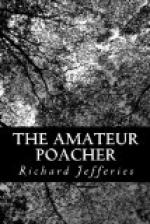Besides poachers, the eggs have to run the chance of being destroyed by carrion crows, and occasionally by rooks. Rooks, though generally cleanly feeders, will at times eat almost anything, from a mussel to a fledgeling bird. Magpies and jays are accused of being equally dangerous enemies of eggs and young birds, and so too are snakes. Weasels, stoats, and rats spare neither egg, parents, nor offspring. Some of the dogs that run wild will devour eggs; and hawks pounce on the brood if they see an opportunity. Owls are said to do the same. The fitchew, the badger, and the hedgehog have a similarly evil reputation; but the first is rare, the second almost exterminated in many districts; the third—the poor hedgehog—is common, and some keepers have a bitter dislike to them. Swine are credited, with the same mischief as the worst of vermin at this particular season; but nowadays swine are not allowed to run wild in cultivated districts, except in the autumn when the acorns are falling.
As the nests are on the ground they are peculiarly accessible, and the eggs, being large, are tempting. Perhaps the mowing machine is as destructive as anything; and after all these there is the risk of a wet season and of disease. Let the care exercised be never so great, a certain amount of mortality must occur.
While the young partridges gradually become strong and swift, the nuts are increasing in size, and ripening upon the bough. The very hazel has a pleasant sound—not a nut-tree hedge existed in the neighbourhood that we did not know and visit. We noted the progress of the bushes from the earliest spring, and the catkins to the perfect nut.
There are threads of brilliant scarlet upon the hazel in February, though the gloom of winter lingers and the ‘Shuck—a—sheck!’ of the fieldfare fleeing before the snow sounds overhead. On the slender branches grow green ovals, from whose tips tiny scarlet plumes rise and curl over.
It often happens that while the tall rods with speckled bark grow vigorously the stole is hollow and decaying when the hardy fern flourishes around it. Before the summer ricks are all carted the nuts are full of sweet milky matter, and the shell begins to harden. A hazel bough with a good crook is then sought by the men that are thinking of the wheat harvest: they trim it for a ‘vagging’ stick, with which to pull the straw towards them. True reaping is now never seen: ‘vagging’ makes the short stubble that forces the partridges into the turnips. Maple boughs, whose bark is so strongly ribbed, are also good for ‘vagging’ sticks.
Nut-tree is used for bonds to tie up faggots, and split for the shepherds’ hurdles. In winter sometimes a store of nuts and acorns may be seen fallen in a stream down the side of a bank, scratched out from a mouse’s hole, as they say, by Reynard, who devours the little provident creature without regard for its wisdom. So that man and wild animals derive pleasure or use from the hazel in many ways. When the nuts are ripe the carters’ lads do not care to ride sideways on the broad backs of the horses as they jog homewards along the lane, but are ever in the hedges.




